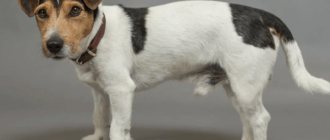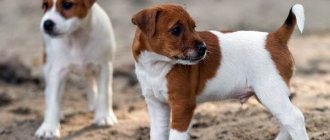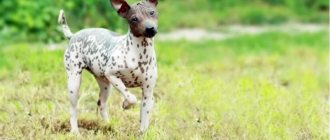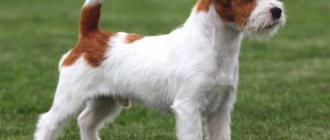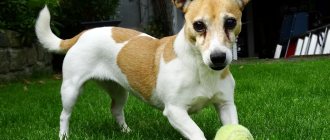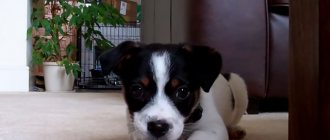The Jack Russell Terrier today is more often perceived as companion dog. But for those who decide to choose a representative of this breed as a pet, it is important to consider that this is not a funny toy, but a brave and capricious fox hunter. Dogs have a need for constant physical activity, require a competent approach to their socialization.
History of the origin of the breed
The breed is named after the English clergyman who selected it. John Parson Jack Russell, was fond of hunting, was a breeder of fox terriers. In 1873, he founded the club and participated in the development of breed standards.
White terriers were in demand among hunters because they cannot be shot if confused with a badger or a fox; their ears protect the ear canal from dirt during burrow hunting. The ancestor of the breed is considered to be a bitch nicknamed Trump. Jack Russell bought her from a market trader because he was fascinated by her unusual appearance. The dog was white with red spots and looked like a fox.
From this moment selection work began. Most likely, the ancestors of the Jack Russell Terrier were old-type fox terriers, English terriers, Welsh corgis, and bulldogs. The breeder believed that the desire to kill and aggression did not correspond to the principles of traditional British hunting.
The dog was not intended to mutilate game. He had to drive her out of the hole by barking. The little hunter's sonorous voice is due to the admixture of beagle blood. The priest conducted a strict selection, aimed primarily at improving the working qualities of the dog, caring little about its appearance.
Neighboring farmers learned about Russell's cunning and hardy dogs. The breed began to spread. In 1974, the priest acted as a judge for the only time at an exhibition of his terriers. He himself considered this breed to be exclusively working, not created for showing.
However, hunters appreciated the advantages of the Jack Russell Terrier. Dogs began to be used to catch foxes, badgers, and game birds. In horse hunting, dogs were used to follow the bloody trail to search for wounded deer or roe deer.
Some have tried to improve the fearless Priest Terriers by adding aggressiveness to them by crossing them with Bull and Terriers. With the ban on dog fighting in the mid-19th century, experimentation ceased.
Some traces of them have survived to this day in individuals with black spots. They look rougher in comparison with their white-red counterparts, have more massive heads and a straight bite.
There was no information about the Jack Russell Terrier dog breed outside Foggy Albion. The dogs gained fame in the 20th century, when several individuals were taken to Australia. Dog handlers from a distant continent liked the funny, brave dogs. They added local terrier blood to them, improving the appearance of British working dogs.
Jack Russell Terriers appeared in Russia in the late 1990s, but were viewed with skepticism by dog breeders. They were mistaken for “rejected” short-haired fox terriers.
After the release of the film “The Mask”, where the Jack Russell Terrier was filmed as the dog Milo, dogs began to be in demand. In 2003, the first National Club of Breed Fans was opened.
Today this is one of the most popular breeds among residents of megalopolises, who appreciate its original appearance, ease of care, and cheerful disposition.
Modern Jack Russell Terrier
Two hundred years of breed improvement have not passed without a trace for the Jack Russell. Modern representatives bear little resemblance to the first puppies bred. Today's representative of the species is an ideal hunter.
Qualities carefully incorporated into the breed’s genotype:
- Wool length
. The Jack Russell is focused on hunting in earthen burrows, so short hair helps him shed clods of earth faster. The terrier, covered in mud, could not develop sufficient speed, so he often lost sight of the fox. - White color
. Light-colored fur helps a hunter instantly distinguish a dog running out of a hole from a fox. When working with the same terriers, the shooter often shot at his own dog, mistaking it for prey. - Drop ears
. Thanks to this structure of the auricle, the ear canal is protected from moisture, dirt and other misfortunes that distract the puppy from work.
The origin of all these qualities in the breed was laid by Russell himself. Breeders were only engaged in improving the species.
High demands concerned not only the exterior, but also behavioral qualities. A miniature hunter must be brave and swift. A true Jack Russell will not be intimidated by large prey or the difficulty of catching.
The life of a modern dog is not limited to hunting. The breed is increasingly being kept as a pet and companion. Farmers in England respect the dog for its protective qualities.
Description of the breed with photos
The final standard for the Jack Russell Terrier breed was approved only in 2012. Dog handlers classified him as a small but hardy hunting dog.
The purebred Jack Russell meets the following characteristics:
- the body is slightly elongated, flexible, strong;
- the back is strong, with a slightly convex loin;
- chest deep;
- muscular limbs;
- nose is black;
- lips fit tightly to teeth, painted black;
- cheeks with developed muscles;
- ears raised, tips tilted forward;
- The eyes are medium-sized, dark, almond-shaped, with a black edge. Convex, with non-closed eyelids are considered a defect;
- powerful neck;
- the tail is set high, straight, and takes a vertical position when moving;
- the jaws are powerful and wide;
- scissor bite.
According to the description of the breed, the dog's gait is light and springy. In general, Jack Russell Terriers give the impression of being strong, active, emotional animals. Sluggish movements are considered a fault. Breed defects include aggression or cowardice.
Size and weight
Jack Russell females and males do not differ much in size. Their height is from 25 to 30 cm . Weight should be proportional: 1 kg for every 5 cm of height.
At first glance, representatives of the Jack Russell Terrier breed look disproportionately long. This shape was deliberately given to the dog by breeders so that the animal could cope with the tasks of burrow hunting.
Color and coat type
Based on coat type, Jack Russell Terriers are divided into three groups:
- smooth-haired with a dense undercoat, a hard pile adjacent to the skin, more suitable for hunters. The fur does not prevent the dog from moving in the hole. Soft to the touch, thin hair is considered a defect;
- wire-haired type has coarse, long hair that sticks out slightly to the sides. This type of dog looks shaggy;
- intermediate view Jack Terrier is called "broken", which means “broken” in English. These dogs have the longest coat, with kinks in several places. The eyebrows and beard of these dogs practically do not grow.
Attention: it is possible to determine what type of coat a puppy will have no earlier than 3 months of age.
Even an experienced breeder cannot always tell from a newborn Jack Russell what type it is. One litter can contain dogs of different species .
The main color of the little hunters is white with spots of black or different shades of brown. The spots are round in shape and should not occupy more than 30% of the animal’s body.
Distinctive features
Chihuahuas have very loose standards. This applies to both body size and shape. They can be smooth-haired or long-haired. It is believed that the former were crossed with Pinschers, and the latter with Spitz. A litter can have completely different puppies in color, size, and coat length.
There is a separate type that is not considered standard. This is Tikap Chihuahua - a dog that fits in a cup. Their weight is less than 500 grams, and the cost is several times higher than for an ordinary dog. Such pets are considered the most glamorous pocket dogs, but most often they are very weak due to prematurity and are susceptible to many diseases.
In general, the dogs are well built and muscular, despite their size. The body format is elongated, the limbs and head are proportional to the size of the body.
- Apple-shaped head: round, small. Let's say a fontanel. The stop is well marked.
- The muzzle is shortened, straight, wide, narrowed towards the nose. The jaws are strong and have a scissor bite (the upper teeth overlap the lower teeth). The lips are thin and fit tightly. Cheeks are dry.
- The nose is upturned, short, of any color;
- The eyes are large, round, not protruding. A light iris is acceptable; dark brown is preferred.
- The ears are large, thin, rounded, but narrowed towards the end (not sharp); placed on the sides of the head. Puppies have drooping ears, later rising to erect ears. The angle between the ears at rest is 45°.
- The body is small, strong, elongated. The topline is straight with a wide back and a straight croup. The chest is wide, but not barrel-shaped. The neck is short and curved.
- The tail is set high, straight, the ideal shape is crescent-shaped, slightly curved towards the back.
- Limbs are parallel, strong, of medium length. A straight and moderately wide stance is considered correct. The paws are small and oval. The movements are sweeping and springy.
- The coat can be long or short. Smooth-haired Chikhovs are characterized by short, close-lying hair. For long-haired dogs – soft, wavy or straight, silky. The undercoat should not be too thick or long.
- Colors: Any colors and combinations are acceptable.
Health and illness
Breeders carefully monitor the gene pool, but there are still some hereditary diseases inherent in this breed.
The most common of them:
- cataract;
- displacement of the lens. Not common, appears at the age of 3 or 8 years;
- deafness;
- hip dysplasia;
- ataxia (irregularity of muscle movements);
- myasthenia gravis (muscle weakness)
- necrosis of the femoral head (Legg-Calvé-Perthes syndrome);
- displacement of the kneecap;
- Von Willebrand disease (spontaneous bleeding).
Regular visits to the veterinarian and the owner’s attention to the pet will help minimize risks.
Lifespan
Jack Russell Terriers are naturally endowed with a strong immune system and good health . With proper care, their life expectancy is 13-16 years .
In order for your pet to remain healthy for many years, you need to take into account the characteristics of this breed when caring for it. The hunting instincts of dogs push them into contact with wild animals, so timely vaccination of the pet against deadly infections is very important.
Dog's name
A dog named Milo demonstrated not only the power of a dog's devotion, but also showed remarkable ingenuity in the movie scene with the keys. The clever craftsman who played the role of Stanley Ipkiss's little friend was named Max.
It's surprising that the viewer was not deceived. For example, the famous Lassie was played by male actors.
Among the interesting facts inherent in the four-legged actor or his brothers in the breed, the following should be highlighted:
- Emotionality
. Animals quickly become attached to their owners and express any feelings with the help of a loud bark. - Jumpability
. High jumping 150 cm is a favorite activity of terriers. It is important for the owners to mentally prepare for his athletic tricks. - Max has experience
. The terrier managed to appear on the big screen back in 1991 in the role of the funny Gryzlik from the film “Problem Child”. - Fearlessness
. Miniature size does not matter in times of danger. The dog always shows persistence and is not inferior to larger breeds. - Perpetuated the memory of the founding father
. The first breeder and subsequent founder was the Englishman Russell John. - Love of digging
. The hunting spirit of their ancestors allows them to dig deep holes in a short time, so they love to dig in their personal yard. - Mystical coincidence with the director's surname
. Chuck Russell certainly didn't cast based on his own last name, but the end result is questionable. - Longevity
. Milo lived a long and happy life. Having left the world at the age of 16, he left a reliable replacement in the person of his son Enzo.
Frank Welker, who is remembered for his roles as the monkey Abu and the charming chubby Garfield, was responsible for the voice acting.
Character and intelligence
Jack Russell Terriers have a cheerful, playful disposition. At the same time, they are decisive and independent. These are not lap dogs; they prefer constant movement and frequent changes of environment.
The pet must always be busy, otherwise the fidget will find entertainment for itself. He will begin to spoil things, dig holes in the floor or upholstered furniture.
If you do not give your dog enough attention, it may develop nervous disorders and the animal will become uncontrollable.
Many terrier owners “calm down” their baby with long walks and exhausting running after the ball. After active games, the pet gets tired and behaves more calmly at home. The playfulness of such dogs lasts their entire lives.
A characteristic feature of Jack Russell Terriers is their “talkativeness”. Sociable dogs make sounds almost constantly: from weak squeals to loud barks.
They react with their voice to extraneous sounds, the doorbell and others. Because of this behavior of the pet, the owners may have problems in relations with their neighbors.
The Russell Terrier is an owner, he does not tolerate people taking his bowl, toys, or bedding. The jealous attitude also extends to the owner. The dog will vehemently protest if the owner begins to devote time to other pets.
Unlike many other breeds, the Jack Russell Terrier does not require a “leader” owner ; he can choose one of the family members as his favorite.
When walking, you need to carefully monitor your dog. The little hunter is distinguished by his unbridled courage and can enter into a fight with a dog much larger than himself . This may result in your pet being seriously injured.
Attitude towards children and others
The restless, cheerful and brave Jack Russell Terrier loves children very much and takes an active part in all their games. But families with children under 3 years old should not have a representative of this breed.
Dogs do not tolerate careless treatment. If a dog is pulled by the tail or ear, it will snap, which can frighten the baby. In addition, with such a pet it will be problematic to follow the baby’s daily routine; the dog will wake him up with loud barking. This breed does not show direct aggression.
Jack Russells are happy to play even with other people's children, but they are wary of adult strangers.
Attention: funny dogs are used in complex therapy of children suffering from autism and cerebral palsy.
They are aggressive towards other dogs. If two terriers live in the house, it is better not to leave them alone. Representatives of the breed jealously guard their territory and can fight. We must not forget that this is a hunting breed.
You cannot breed hamsters or rabbits at the same time as a Jack Russell - dogs perceive them exclusively as prey.
The terrier should only be taken outside on a leash. He may chase the cat, get lost, or get hurt.
Only early socialization and proper upbringing of the pet will help reduce the risk that the dog will get into trouble.
Education and training
Jack Russells are endowed with a sharp, lively mind. They easily remember commands and enjoy training, but only as long as they are interested in them. Dogs love active entertainment; exercise in the form of a game will quickly bring the desired result.
It is important to remember that terriers are very stubborn . When raising a dog, the owner will need patience and perseverance.
Attention: the breed is easy to train, suitable for beginner dog breeders.
Jack Terrier puppy training should begin at two months of age. The baby needs to be taught the rules of behavior in the house.
In order not to take the dog out for a walk in bad weather, he is taught to relieve himself in a special diaper.
The puppy should be placed there immediately after sleep, 10 minutes after eating, when he begins to worry and sniff the floor. During bowel movements, your pet should not be scolded or moved - such mistakes can provoke behavioral disorders. Every time after the dog pees on the spot, he must be encouraged.
The second important point is to wean the puppy from biting. For him, this is part of the game, not aggression. You need to demonstrate to the dog that his actions are causing pain. To do this, you can scream after the bite and leave the room for a while.
Jack Russells strive to please their owner, so they will try not to upset him. When a baby's teeth change and his gums itch, he needs to be provided with a sufficient number of toys.
The third task of the owner is to make sure that the dog does not bark when left alone at home. To do this, you need to leave the room, increasing the time you are absent. Return only when the puppy is silent. You should be patient so that the terrier does not think that the owner is returning to his voice.
A well-mannered dog must follow basic commands:
- "place";
- "ugh";
- "to me";
- "sit";
- "lie";
- "near".
The Jack Russell must be trained correctly. The first workouts should last a couple of minutes, with a gradual increase in exercise time to half an hour. You can start mastering a new command only after mastering the previous one.
For each completed task, the puppy is rewarded with a treat or praise. You can't hit the dog. It is enough to say the command in a stern voice, pause for a second and repeat the order.
Attempts to dominate must be stopped immediately. The dog should not eat from the common table, jump on the bed, or put its front paws on people. The dog must calmly give toys and food to the owner. You can’t give your baby your old things to tear apart, otherwise in the future the terrier will spoil anything, and it’s extremely difficult to wean him from doing this.
The exhibition animal must calmly accept the judges' examination of the teeth, joints, and testicles. Aggression in this case is the reason for disqualification.
For shows you need to learn a special step. It is necessary for the dog to walk calmly at the owner’s left leg with a wide, smooth stride with a straight back.
To train for exhibition running, you should run next to the dog, holding him on a leash, jerking to stop jumping. The desired pace is encouraged by voice.
The problem is training a fidget to do a show stand, in which the Jack Russell Terrier needs to freeze for a couple of minutes. To do this, you need to praise and encourage with treats long-term immobility after the “ring” command.
Training a little hunter
Raising any hunting dog is fraught with difficulties. The Jack Russell Terrier was no exception. The small and energetic hunter will definitely try to command the parade. The owner will need tremendous endurance and strength of character.
The Jack Russell Terrier has a dominant mentality
Education begins the moment the puppy first comes into the home. The place of the dog is of great importance. This applies to both physical rookery and position in the family hierarchy.
Despite its miniature size, the Jack Russell is a strong-willed and strong dog. The breed has a dominant mentality, so it will definitely try to dominate the house. The dog's desire to dominate can be compared to the habits of large breeds. For example, a mastiff. In everyday life, the Jack Russell will not blindly obey. Most likely, he will become a loyal and intelligent partner.
The breed has a high need for communication. Loneliness for the Jack Russell Terrier is akin to real torture. Separation from the owner is difficult and painful. Left at home, he will definitely start damaging property. You can’t punish a dog for this, because it’s just trying to eat away its melancholy with a piece of the sofa. To make separation less painful, your pet should be provided with unfamiliar toys and new experiences. The dog’s favorite treats will also brighten up the loneliness.
The training is based on the formation of an adequate canine character, for which the owner’s commands will take precedence over instincts. Everything that is prohibited for an adult animal should be stopped already in puppyhood. In this case, prohibitions are necessarily expressed in a stern voice, but not with punishment. Rudeness provokes aggression on the part of the pet, which is unacceptable when raising a home companion.
The basis of dog training is the formation of an adequate canine character
Training a pet depends on the owner's goals. Hunting and show dogs are trained using different methods. However, every dog must be able to perform a number of mandatory commands. These include the orders “Sit,” “Wait,” “Down,” and “Ugh!”
The transition to the next command occurs when the dog unconditionally fulfills the previous one. However, the order should not be repeated twice. If the dog understands that a command can be ignored, he will definitely use this right.
When training, it is important to find that fine line between a self-confident and obedient dog.
Pros and cons of the breed
Before you get a Jack Russell Terrier, you need to consider the positive and negative aspects of this breed.
We present the main ones in table form.
| pros | Minuses |
| cheerful, playful disposition | restlessness |
| sharp mind | ability to manipulate |
| the hunter's instinct is developed | does not get along with other animals |
| easy to care for | constant shedding |
| ability to train | stubbornness |
| bravery | desire to fight |
| good guard | loud barking |
| devotion to the owner | jealousy, possessiveness |
| loves children | a baby can be frightened by barking |
In order for Jack Terriers to demonstrate positive character traits to a greater extent, it is important to provide them with proper education and care.
Scottish Setter in the film "White Bim Black Ear"
Tough, strong, hardy, affectionate, intelligent and loyal - this is how you can characterize the Scottish Setter. These dogs have an innate exceptional sense of smell, a balanced character, tireless energy, and are very easy to train. These are absolutely alive, active, calm and cheerful creatures. The love and devotion of the Scottish Setter to its owner has no boundaries, which is perfectly shown in the very sad and touching picture “White Bim Black Ear.” The example of the dog Bim very accurately demonstrates the boundless loyalty of these animals. They always strive to be useful, get along well with children, can fearlessly rush at the offender of someone they love, and endure all hardships with steadfastness. The Scottish Setter is an incredibly loyal friend, ready to do anything for his owner, for whom he is a source of real pride.
Text: Victoria Karban Date: December 6, 2014
Maintenance, care and nutrition
The ideal place of residence for a Jack Russell Terrier is a country house with a garden plot where the dog can frolic and bark to its heart’s content.
It is important that the area is surrounded by a high fence. Even in this case, you will have to make sure that the dog does not dig under the fence.
You can keep your pet in a city apartment when it is possible to provide him with long, active walks.
In maintaining hygiene, the main difficulty is caring for the pet’s specific coat, especially if it belongs to the long-haired variety. Such dogs need to be trimmed regularly (pluck out dead hairs).
Russell terriers with any long coat should be combed and brushed with a hard mitten (or a damp towel). You shouldn't bathe your dog often. Constant washing destroys the hair's natural oils and spoils the hair. Dogs must be bathed before the exhibition, bitches - after estrus.
The Jack Russell Terrier's ears are cleaned weekly with a sterile swab containing a special solution, which can be purchased at a veterinary pharmacy or pet store. The ear canal itself cannot be cleaned; only the visible part of the cartilage needs to be wiped. After the procedure, the ear is blotted dry with a clean napkin.
Nails should be inspected regularly and trimmed if necessary to prevent damage to the paw pads.
If the dog's eyes become dirty, wipe them with a cotton swab moistened with a weak solution of boric acid. If the whites and eyelids are red, your pet most likely has conjunctivitis. In this case, you should contact your veterinarian as soon as possible and treat your eyes only with the medications he prescribes.
Whether a Jack Russell Terrier's tail needs to be docked depends on what the dog was purchased for. The procedure was carried out for hunting dogs for safety reasons, to avoid injury to the animal in the fox hole.
Nowadays, dogs are more often used as companions; there is no need for surgical manipulation. The decision to dock the tail or not must be made by the owner himself.
The operation is best performed at the age of 3-10 days. At this time, the circulatory system and nerve endings of the limbs are not yet fully formed, the procedure, as well as the rehabilitation period, will be almost painless. You can dock an older pet, but not older than six months. In this case, you will have to use anesthesia.
In order for your dog to grow up healthy, it is important to provide him with proper nutrition. Jack Russell can eat commercial food or natural food. In the first couple of weeks, it is advisable to feed the puppy the same thing that he ate from the breeder. Your pet should be transitioned to a new diet gradually, following certain rules:
- dry food in a soaked form must first be mixed into canned food or homemade food;
- add any new product little by little, starting with a teaspoon;
- translation into “natural” should start with meat broths, then include vegetables, then cereals;
- Give vitamins only in consultation with a veterinarian.
The diet of an adult dog should include the following foods:
- beef;
- buckwheat;
- pumpkin;
- boiled chicken;
- beet;
- rice;
- carrot
- dairy products;
- thoroughly boiled heart (the terrier should not be given other offal products);
- zucchini.
Those who prefer to feed their pet industrially produced food should choose at least premium products. To feed Jack Russell Terriers, breeders recommend using food from the following brands:
- Canide;
- Innova EVO;
- Akana;
- Artemis Maximal Dog;
- Orijen.
Dry food is good because it contains all the vitamins and microelements the animal needs.
It is forbidden to feed your pet food from the common table, fatty, fried, hot, spicy dishes, as well as sweets.
How to choose a puppy
A purebred puppy should only be purchased from specialized nurseries or from trusted breeders. The cost of such a Jack Russell Terrier is 500-1200 dollars, depending on the title of the parents.
You can, of course, purchase a puppy without documents from an ad on the Internet for $100-300. This should not be done, as there is a high risk of getting a defective or diseased individual.
Attention: parental championship does not guarantee that all animals in the litter are show class.
When choosing a Russell Terrier puppy, you need to pay attention to the following characteristics of the animal:
- mobility, lack of fear. Lethargy or cowardice are disqualifying characteristics for this breed;
- the color is predominantly white;
- no extra fingers;
- The teeth are straight and white. Scissor bite;
- Males have two testes completely descended into the scrotum.
Any elite puppy has a brand (or microchip), a veterinary passport, and a medical certificate.
It is better to buy a dog for exhibitions at 5-6 months. By this age, all breed characteristics are fully formed in the baby. It is advisable to purchase a working dog at the age of two months in order to raise it “for yourself.”
If you are not very well versed in the breed, carefully study the standards before purchasing and consult with specialists.
Video about the breed
The choice of breed is crucial, determining the future life of not only the dog, but all members of the family into which it ends up. Phlegmatic people who like to spend time in a quiet home environment should not get a Jack Russell Terrier - a lack of activity will negatively affect the dog’s character, behavior, and health.
This breed is for those who love sports, walks, and outdoor games. In a comfortable environment, little hunters will show their best qualities and become a devoted friend and reliable companion for a loving owner in any life situations.
Milo was voiced by Frank Welker in the film.
After the success of the film, an animated series was released under the same name, “The Mask.” Milo the dog has often appeared on various television shows. Milo's voice was provided by Frank Welecker, who has also voiced many other similar characters, including Scooby-Doo, Droopy, Santa's Little Helper; he also provided the voices of other animals, such as Abu in Aladdin and Garfield the cat in several cartoons.
